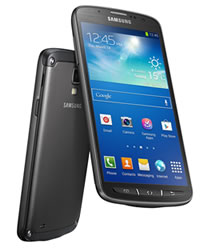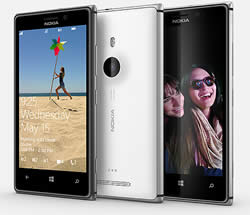Difference between Samsung Galaxy S4 Active and Nokia Lumia 925
Key Difference: Samsung announced that it has added a new phone to its lineup that combines the ruggedness of the older Samsung Xcover with the features and oomph of the new Galaxy S4. S4 Active is dust and water-proof. The phone comes with a 5-inch Full HD TFT capacitive touchscreen that differs from the AMOLED used in the S4. Nokia has recently announced its new flagship phone the Nokia Lumia 925. The phone comes with a 4.5-inch AMOLED capacitive touch screen which takes up a good amount of space on the front, with the speaker and sensors on the top. The 4.5-inch capacitive screen has the same PureMotion HD+, ClearBlack that is found in Lumia 920.
 Samsung announced that it has added a new phone to its lineup that combines the ruggedness of the older Samsung Xcover with the features and oomph of the new Galaxy S4. S4 Active is dust and water-proof and aims to provide direct competition to the Sony Xperia Z. The phone is aimed at the users that require their phone to be durable as well as provide extra features. According to the CEO and President of IT & Mobile Communications Division at Samsung Electronics, JK Shin, the phone is designed for the people who love the outdoors.
Samsung announced that it has added a new phone to its lineup that combines the ruggedness of the older Samsung Xcover with the features and oomph of the new Galaxy S4. S4 Active is dust and water-proof and aims to provide direct competition to the Sony Xperia Z. The phone is aimed at the users that require their phone to be durable as well as provide extra features. According to the CEO and President of IT & Mobile Communications Division at Samsung Electronics, JK Shin, the phone is designed for the people who love the outdoors.
Samsung Galaxy S4 Active shares many features with the S4, but differs in terms of design and aesthetics. The S4 Active is thicker and heavier at 151 grams; the weight is mostly because of the added water and dust proof. The phone has a diamond-pattern textured back that makes it easier to hold the device. The company has also removed the capacitive buttons and replaced them with hardware buttons. The top of the phone houses the 3.5mm headphone jack and has the words waterproof etched next to it. The top also houses the secondary mic and the IR emitter. The volume rocker is on the left side of the phone, while the right side has the power/lock key. The bottom of the phone has the microUSB / MHL 2.0 port that is sealed with a plastic flap. The proximity sensor, light sensor and the IR motion detector are placed on the front above the screen near the speaker. The back of the screen houses the camera and the LED flash.
The phone comes with a 5-inch Full HD TFT capacitive touchscreen that differs from the AMOLED used in the S4. It has ~441 ppi pixel density and is protected by corning gorilla glass 3. The phone is powered by 1.9 GHz Krait 300 Quad-core Qualcomm Snapdragon 600, has Adreno 320 GPU and 2GB RAM. The phone comes with Android 4.2.2 Jelly Bean. The TouchWiz UI changes certain Jelly Bean features offering users with more options. The lockscreen features new widgets such as displaying personal messages overlaid on photos from the TripAdvisor. The water ripples effect has been replaced by the lens flare effect, but can be switched or disabled completely. The lockscreen also offers multiple screen on which users can add widget. Another cool feature is the Quick Glance feature that uses a proximity sensor to detect nearby movement and automatically lights up to display time and notifications.
The company has replaced the 13 MP camera with an 8MP rear camera that as a capability to work underwater. The volume rocker can be changed into a temporary camera shutter button that allows users to click photos and record videos underwater. The hardware buttons are also provided for the same purpose. The phone offers 16 GB internal storage capacity of which around 11 GB is available to the user. However, the storage can be expanded by 64 GB using a microSD card.
The same amazing features that were offered in Galaxy S4 is available in the S4 Active; including gestures, hovering, air wave, smart play, smart scroll and many other fun features. The phone also comes with an Aqua Mode that can be applied to increase visual quality and clarity for enhanced underwater images. The company has also added certain helpful Samsung Apps including Samsung Hub, S Travel (Trip Advisor), S Health and S Translator that can translate as well as pronounce many different kinds of language. The camera also comes with many different features such as Drama Shot, Sound&Shot, Story Album and Group Play. However, it is unsure if the phone offers Dual Shot or Dual recording. The phone also comes with a IR blaster that can covert the phone into a remote.
 Nokia has recently announced its new flagship phone the Nokia Lumia 925. This phone is in lines with the other new Nokia Lumia 928, but differs from its cousin in many ways. The Nokia Lumia 925 was also known as “Catwalk” phone for a long time before it was officially announced. The company has maintained a similar design to its Lumia phones but has added a metal band. This is the first phone that will feature a mix of plastic and metal. However, the back is still made of polycarbonate plastic. The phone is made slim and light weight making it comfortable to hold. The phone’s frame is made of aluminum with only the back made of plastic. However, the back is non-removable so the battery is not easily accessible.
Nokia has recently announced its new flagship phone the Nokia Lumia 925. This phone is in lines with the other new Nokia Lumia 928, but differs from its cousin in many ways. The Nokia Lumia 925 was also known as “Catwalk” phone for a long time before it was officially announced. The company has maintained a similar design to its Lumia phones but has added a metal band. This is the first phone that will feature a mix of plastic and metal. However, the back is still made of polycarbonate plastic. The phone is made slim and light weight making it comfortable to hold. The phone’s frame is made of aluminum with only the back made of plastic. However, the back is non-removable so the battery is not easily accessible.
The device is available in black, white or grey, so don’t look for the bright colors that are expected of other Nokia phones. The phones comes with a 4.5-inch AMOLED capacitive touch screen which takes up a good amount of space on the front, with the speaker and sensors on the top and the three capacitive buttons (Home, Back and Menu) on the bottom. Similar to the other high-end Lumias, the top of the device holds audio jack, the microUSB port and the SIM slot. The left and the bottom side of the device is bare, while the right side has the volume rocker, the power button and the dedicated camera button making it a little too crowded.
The 4.5-inch capacitive screen has the same PureMotion HD+, ClearBlack that is found in Lumia 920. The ClearBlack technology plus the HD OLED screen offers sharp, clear images and also spectacular viewing in sunlight. The phones provides a good contrast and vibrant colors but the difference is not really that apparent when using day-to-day.
Under the hood, the phone is powered by Dual-core 1.5 GHz Krait Qualcomm MSM8960 Snapdragon, the same processor used in Lumia 920 and 928. The processor is fast and responsive, but lags when it comes to camera. The phone comes with Adreno 225 and 1 GB RAM, compared to the 2G found in its competitors. The phone comes with only 16 GB internal memory and does not offer users to extend it using an external card. The phone integrates the Windows Phone 8 OS, which works seamlessly. However, again similar to all other Windows Phones, the app stores lack many apps and still has yet to reach its potential.
The phone comes with an 8.7MP rear camera and a 1.3MP front camera. The camera comes with upgraded technology that uses a 1/3'' sensor size to take more high-res photos. The camera also comes with Nokia’s Smart Camera technology that allows taking 10 photos at once, which can then be altered to create the perfect photo. This is similar to the Zoe technology found on HTC One that takes mini videos along with photos. The company has also added an additional lens on the five-lens that allows taking much better photos. Nokia also boasts about its low-light imaging technology that allows users to take excellent photos in low-lighting conditions. The imaging technology is quite superior and does take excellent images with less blur. However, the camera shutter is quite slow which requires the user to hold the phone with a steady hand to eliminate motion blur.
The company also has removed the built-in wireless feature to cut down on the weight, but has added it as an option by purchasing the wireless cover. The phone comes with a non-removable Li-Ion 2000 mAh battery that allows the phone to go longer periods of time without requiring charging. The phone also comes with a few nifty features that make it stand out. The new phone is slick, thin and has decent features. It could just be phone that turns the tide in favor of Nokia Windows Phone.
The information for the detailed table about the two phones has been taken from Samsung Press website, Nokia website and GSMArena.com.
|
|
Samsung Galaxy S4 Active |
Nokia Lumia 925 |
|
Launch Date |
Q3/2013 |
June 2013 |
|
Company |
Samsung |
Nokia |
|
Size |
139.7 x 71.3 x 9.1 mm |
129 x 70.6 x 8.5 mm |
|
Display |
5-inch Full HD TFT capacitive touchscreen |
4.5 inches AMOLED capacitive touchscreen |
|
Screen |
1080 x 1920 pixels (~441 ppi pixel density) 16M colors |
768 x 1280 pixels (~334 ppi pixel density), 16M colors |
|
Protection |
Corning Gorilla Glass 3 |
Corning Gorilla Glass 2 |
|
Weight |
151 grams |
139 grams |
|
2G Network |
GSM 850 / 900 / 1800 / 1900 |
GSM 850 / 900 / 1800 / 1900 |
|
3G Network |
HSDPA 850 / 900 / 1900 / 2100 HSDPA 850 / 1900 / 2100 |
HSDPA 850 / 900 / 1900 / 2100 - RM-892, RM-893 HSDPA 850 / 900 / 1700 / 1900 / 2100 - RM-910 |
|
4G Network |
LTE 800 / 850 / 900 / 1800 / 2100 / 2600 LTE 700 MHz Class 17 / 850 / 1700 / 1900 / 2100 - SGH-I537 |
LTE 800 / 900 / 1800 / 2100 / 2600 - RM-892 LTE 700 / 1700 / 2100 - RM-893 |
|
GUI |
TouchWiz UI |
Windows Phone 8 |
|
CPU speed |
1.9 GHz Krait 300 Quad-core |
Dual-core 1.5 GHz Krait |
|
GPU |
Adreno 320 |
Adreno 225 |
|
OS |
Android OS, v4.2.2 (Jelly Bean) |
Windows Phone 8 |
|
Chipset |
Qualcomm APQ8064T Snapdragon 600 |
Qualcomm MSM8960 Snapdragon |
|
RAM |
2 GB |
1 GB |
|
SIM Size |
microSIM |
microSIM |
|
Internal Memory |
16 GB (Approximately 11.25 GB available to user) |
16 GB |
|
Expandable Memory |
Up to 64 GB |
N/A |
|
Sensors |
Accelerometer Sensor, Proximity Sensor, Gyro Sensor, Digital Compass, Barometer Sensor, Gesture Sensor, Finger Hovering Sensor, Light Sensor |
Ambient light sensor, Accelerometer, Gyroscope, Proximity sensor, Magnetometer, Orientation sensor |
|
Connectivity |
Wi-Fi ac, Wi-Fi Direct, IrDA, NFC, USB 2.0, Bluetooth® 4.0 (LE), USB-On-the-go, USB Host, DLNA, Wi-Fi hotspot |
SIM, microUSB, 3.5mm audio, USB, Bluetooth, Wi-Fi, NFC, Wi-Fi Channel bonding |
|
Data |
GPRS, EDGE, WLAN, Bluetooth, NFC, Infrared port, USB |
GPRS, EDGE, WLAN, Bluetooth, NFC and USB. |
|
Speed |
HSDPA, 42 Mbps; HSUPA, 5.76 Mbps; LTE, Cat3, 50 Mbps UL, 100 Mbps DL |
HSDPA, 42.2 Mbps; HSUPA, 5.76 Mbps; LTE, Cat3, 50 Mbps UL, 100 Mbps DL |
|
WLAN |
Wi-Fi 802.11 a/b/g/n/ac, dual-band, Wi-Fi Direct, DLNA, Wi-Fi hotspot |
WLAN IEEE 802.11 a/b/g/n |
|
Bluetooth |
Bluetooth v4.0 with A2DP, EDR, LE |
Bluetooth v3.0 with A2DP; Object Push profile (OPP) 1.1, Hands-free profile (HFP) 1.5, Advanced Audio Distribution Profile (A2DP) 1.2, Audio/Video Remote Control Profile (AVRCP) 1.4, Phone Book Access Profile (PBAP) 1.1 |
|
USB |
microUSB v2.0 (MHL 2), USB On-the-go, USB Host |
microUSB v2.0 |
|
Primary Camera |
8MP 3264 x 2448 pixels |
8.7 MP, 3264 x 2448 pixels |
|
Secondary Camera |
2 MP,1080p@30fps, dual video call |
1.3 MP, 720p@30fps |
|
Video |
1080p@30fps, dual-video recording |
1080p@30fps, video stabilization |
|
Camera Features |
|
|
|
Sound Enhancement |
Active noise cancellation with dedicated mic |
Dolby Headphone sound enhancement Active noise cancellation with dedicated mic |
|
Audio supported formats |
MP3, AAC, AAC+, eAAC+, WAV, AMR-NB, AMR-WB, MIDI, OGG, IMY, XMF, WMA, FLAC |
ASF, MP4, AAC, AMR, MP3, M4A, WMA, 3GP, 3G2 |
|
Video supported formats |
MPEG4, H.263, H.264, DivX4, VP8, WMV9, WMV 7/8, MP43, Sorenson Spark |
MP4, WMV, AVI, 3GP, 3G2, M4V, MOV |
|
Battery Capacity |
Lithium-ion 2,600 mAh battery |
Non-removable Li-Ion 2000 mAh battery (BL-4YW) |
|
Talktime |
No official data released |
2G: 18 hours 3G: 12 hours |
|
Standby Time |
No official data released |
3G: 440 hours |
|
Available Colors |
Urban Grey, Dive Blue, Orange Flare |
Black, White, Gray |
|
Messaging |
SMS(threaded view), MMS, Email, Push Mail, IM, RSS |
SMS (threaded view), MMS, Email, Push Email, IM |
|
Browser |
HTML5 |
HTML5 |
|
Radio |
N/A |
FM radio |
|
GPS |
GPS with A-GPS support and GLONASS |
GPS with A-GPS support and GLONASS |
|
Java |
via Java MIDP emulator |
N/A |
|
Additional Features |
|
|
Image Courtesy: samsung.com, nokia.com









Add new comment